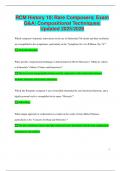RCM History 10| Rare Composers| Exam
Q&A| Compositional Techniques|
Updated 2025/2026
Which composer's harmonic innovations in the use of diminished 7th chords and their resolution
are exemplified in his symphonies, particularly in the "Symphony No. 6 in B Minor, Op. 74"?
Alexander Borodin.
What specific compositional technique is demonstrated in Olivier Messiaen's "Mode de valeurs
et d'intensités" (Mode of Values and Intensities)?
The use of non-retrogradable rhythms and the exploration of the relationship between
rhythmic durations and dynamic intensities.
Which late Romantic composer’s use of extended chromaticism, non-functional harmony, and a
highly personal style is exemplified in his opera "Wozzeck"?
Alban Berg.
What unique approach to orchestration is evident in the works of Jean-Michel Damase,
particularly in his "Concerto for Harp and Orchestra"?
The use of delicate textures and light orchestral colors that blend with the harp, emphasizing
transparency and subtlety.
1
,Which 20th-century composer’s use of polytonality and rhythmic dissonance is featured in his
work "Piano Sonata No. 2" from 1925?
Charles Ives.
In Béla Bartók's "Music for Strings, Percussion, and Celesta," what key thematic device is used
to unify the work’s contrasting sections?
The use of a symmetrical, palindromic structure and thematic transformation across various
instruments.
What is the concept of "Total Serialism" in the works of Pierre Boulez, particularly in his piece
"Le marteau sans maître"?
The systematic organization of not only pitch but also rhythm, dynamics, and articulation,
applying serial techniques across all parameters of music.
Which of Igor Stravinsky’s works is known for its exploration of meter, rhythm, and tonality,
while maintaining a neoclassical style with its use of smaller orchestral forces?
"Symphony in C."
What distinguishes the melodic and harmonic language of Dmitri Shostakovich in his "String
Quartet No. 8 in C Minor, Op. 110"?
The use of fragmented motifs, the incorporation of Jewish folk music, and a mournful,
almost tragic tone reflecting his personal experiences under Stalin’s regime.
2
,Which composer is known for his exploration of microtonality and the integration of Eastern
musical ideas into his compositions, particularly in "Raga Mela" for violin and orchestra?
Harry Partch.
What is the primary characteristic of Jean Sibelius’s "Symphony No. 7 in C Major," particularly
in terms of structure and orchestration?
Its single-movement form, continuous thematic development, and the use of rich orchestral
textures to create a sense of monumental, evolving drama.
How does the harmonic structure of Claude Vivier’s "Lonely Child" differ from traditional tonal
harmony, and what effect does this have on the piece's overall emotional impact?
The use of modal and chromatic harmony that avoids traditional resolution, creating a sense
of ambiguity and introspection.
Which composer’s incorporation of late-Romantic chromaticism and dissonance is exemplified
in his operatic work "Pelléas et Mélisande," and what impact did it have on the development of
modern opera?
Maurice Ravel.
What is the significance of Witold Lutosławski’s technique of "controlled aleatoric music,"
particularly as seen in his "Concerto for Orchestra"?
The use of controlled randomness in rhythm and phrasing, allowing performers freedom
within structured parameters, creating a tension between predictability and unpredictability.
3
, How does the form of Olivier Messiaen’s "Quartet for the End of Time" relate to his synesthetic
approach to composition, especially regarding the relationship between time and sound?
The use of rhythmic cycles, non-retrogradable rhythms, and the blending of temporal
structures with the mystical representation of eternity.
What is the effect of Giacinto Scelsi’s use of a single pitch as the structural center of his
compositions, particularly in works like "Quattro Pezzi" for orchestra?
The exploration of microtonal nuances and oscillating textures around a single pitch,
focusing on gradual transformations and a minimalist approach to harmony.
How does the unconventional use of rhythm and meter in Olivier Messiaen’s "Turangalîla-
Symphonie" relate to his fascination with the concept of time and eternity?
The employment of additive and non-metric rhythms, combined with complex rhythmic
patterns that defy traditional pulse, reflecting his philosophical views on the transcendent nature
of time.
Which composer’s works, including "Symphony No. 5" and "The Firebird," demonstrate a
synthesis of Russian folk elements with complex rhythmic structures and expansive harmonic
language?
Igor Stravinsky.
4




